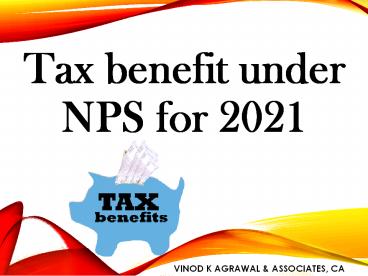Tax benefits under NPS 2021 - PowerPoint PPT Presentation
Title:
Tax benefits under NPS 2021
Description:
The PFRDA (Pension Fund Regulatory and Development Authority) governs the National Pension System (NPS), which is a retirement pension programme established by the Government of India to provide subscribers with a regular income after retirement. NPS in 2021 is the best option to get tax benefits. It may be a smart choice for you because of the low minimum commitment and higher returns for retirement planning. – PowerPoint PPT presentation
Number of Views:108
Title: Tax benefits under NPS 2021
1
Tax benefit under NPS for 2021
VINOD K AGRAWAL ASSOCIATES, CA
2
What is NPS?
- NPS seeks to inculcate the habit of saving for
retirement amongst the citizens. It is an attempt
towards finding a sustainable solution to the
problem of providing adequate retirement income
to every citizen of India.
3
Who regulates NPS?
- Pension fund Regulatory and Development
Authority. - Website https//www.pfrda.org.in/
4
Who can open NPS?
5
Where to they invest money?
- Under the NPS, individual savings are pooled in
to a pension fund which are invested by
professional fund managers as per the approved
guidelines in to the diversified portfolios
comprising of government bonds, bills, corporate
debentures and shares.
6
Which NPS fund are available?
1. SBI Life Insurance Co. Ltd 2. Life Insurance
Corporation of India 3. Star Union Dai-ichi Life
Insurance Co. Ltd 4. ICICI Prudential Life
Insurance Co. Ltd 5. HDFC Life Insurance Co Ltd.
6. IndiaFirst Life Insurance Co Ltd 7.
Edelweiss Tokio Life Insurance Co. Ltd 8. Bajaj
Allianz Life Insurance Co Ltd. 9. Canara HSBC
Oriental bank of Commerce Life Insurance co Ltd.
10. Kotak Mahindra Life Insurance Co Ltd. 11.
Tata AIA Life Insurance Company Limited 12. Max
Life Insurance Company Limited 13. PNB Metlife
India Insurance Company Limited 14. Aditya Birla
SunLife Insurance Company Limited
7
What documents are required?
PAN
Proof of Address
Proof of Bank Account
Photograph
8
What is PRAN?
- Permanent Retirement Account Number
- PRAN is a unique identification number allotted
to a subscriber for his/her Individual Pension
Account opened under NPS. The PRAN remains
unchanged even though the subscriber shifts
employment or location.
9
How much Pension will I receive?
- The amount of pension will depend on the amount
of contributions made, returns on the investments
and the portion of corpus utilised by the
subscriber for purchasing annuity plan from any
of the Annuity Service Providers empanelled with
PFRDA. - Under NPS, there is no implicit or explicit
assurance of benefit and the investments are
subject to market conditions. - To get the pension calculator visit
http//www.npstrust.org.in/content/pension-calcula
tor
10
What happens if you dont make the minimum
contribution?
- If minimum contribution is not received, the
account is categorized as frozen and will get
activated upon making a contribution to the
account.
11
Types of NPS account?
- Tier-I is the Individual Pension Account, which
is the default pension account having all the tax
incentives under Income Tax Act. - Tier-II is an optional investment account
available to a subscriber having an active Tier-I
account. This account has no withdrawal
restrictions and tax benefits.
12
Section 80CCD (1)
- First limit for NPS deduction
- 10 of Basic DA in case employed
- 20 of gross income in case self-employed
- Second limit
- 80C 80CCD(1) Maximum Rs 1,50,000
13
Section 80CCD (1B)
- Rs 50,000
- This is additional deduction, over and above 1.50
limit.
14
Section 80CCD (2)
- Contribution received from Employer is also
allowed as deduction under this section. - Employer should directly contribute to NPS for
claiming deduction. - Maximum 10 of Basic DA
15
Partial Withdrawal Rules
- Tier I after completion of 3 years subscriber
can withdraw 25 of his own contributions for
specific reasons - illness, disability, education
or marriage of children, purchasing property,
starting a new venture. Max 3 times allowed. - Withdrawal from NPS Tier-II account is permitted
at any point of time, without any restrictions.
16
Taxation - Partial Withdrawal
- EXEMPT
17
Tier I Premature Withdrawal
- Allowed after 10 years
- Subscriber can withdraw maximum 20 of the corpus
as lumpsum and minimum 80 of the corpus has to
be utilized for purchasing an annuity plan. - However, if the accumulated corpus is less than
Rs 2.5 lakh, the entire corpus is paid as lumpsum
to the subscriber.
18
Tier I Normal Withdrawal
- on completion of 60 years of age
- subscriber can withdraw maximum 60 of the corpus
as lumpsum - minimum 40 of the corpus has to be utilized for
purchasing an annuity plan for receiving the
pension. - If the accumulated corpus is less than Rs 5
lakhs, the entire corpus is paid as lumpsum to
the subscriber
19
Taxation - Closure
- Exempt upto 60
- To save tax on balance 40 invest in annuity
plan. - Pension received under Annuity plan is taxable as
per slab rate. - Amount received by Nominee on closure of NPS due
to death is fully exempt.
20
Hope it helps!
VINOD K AGRAWAL ASSOCIATES, CA































